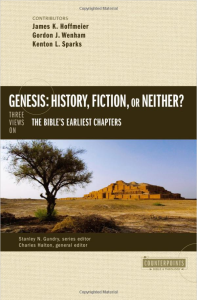Charles Halton, ed. Genesis: History, Fiction, or Neither? Three Views on the Bible’s Earliest Chapters. Counterpoints: Bible and Theology. Grand Rapids: Zondervan, 2015. 173 pp. £10.99/$16.99.
In the last decade the church has witnessed a resurgence of scholarly and pastoral wrestling with the genre and historicity of Genesis 1–11. In this addition to Zondervan’s “Counterpoints” series, seasoned Old Testament scholars James Hoffmeier (= history), Kenton Sparks (= fiction), and Gordon Wenham (= neither) cordially debate these issues, with editor and theology professor Charles Halton (= fiction?) providing introductory and concluding comments. My review of this volume on The Gospel Coalition website is brief yet meaty, and you can access it here. An extended version of the review is now published in Themelios 40.3 (2015): 485–90, which you can access here or read below.
While this volume will best help seminary students and pastors grapple with the issues, every Christian who savors salvation from God’s wrath and who affirms the necessity of the historical, bodily resurrection of the last Adam (1 Cor. 15:14, 17) should consider how important the factuality of Scripture’s earliest chapters is.
This review emphasizes the implications of the three views on the historic Jesus and his saving work. I conclude with a plea for unity around the Jesus of Scripture, “the one who affirmed the historicity of Genesis 1–11, who died a substitutionary death to overcome the sin and wrath problem historically introduced by Adam, and who himself was genealogically connected to the first man, Adam, the son of God.”
*****
Review of Genesis: History, Fiction, or Neither, edited by Charles Halton,” Themelios 40.3 (2015): 485–90.
In the last decade the church has witnessed a resurgence of scholarly and pastoral wrestling with the genre and historicity of Genesis 1–11. In this addition to Zondervan’s Counterpoints series, seasoned Old Testament scholars James K. Hoffmeier, Gordon J. Wenham, and Kenton L. Sparks debate these issues, with editor Charles Halton providing introductory and concluding comments. Hoffmeier teaches at Trinity Evangelical Divinity School in Deerfield, Illinois (USA), and argues that Genesis 1–11 is real history. Wenham tutors at Trinity College, Bristol (UK), and argues that the Bible’s earliest chapters are neither pure history nor fiction. Sparks is a professor at Eastern University in St. Davids, Pennsylvania (USA), and argues that Genesis 1–11 is fiction. Halton teaches theology at Houston Baptist University (USA) and appears to align with Sparks. While this volume will best help learned seminary students and pastors grapple with the issues, every Christian who savors salvation from God’s wrath and who affirms the absolute necessity for the historical, bodily resurrection of the last Adam (1 Cor 15:14, 17) should consider the factual importance of the Bible’s earliest chapters, which narrate the first Adam’s death-bringing role.
View 1: Genesis 1–11 as History
Known for his expertise in ancient Egyptian history and its intersection with the Bible, Hoffmeier helpfully argues that Genesis 1–11 is a mixture of accurate genealogy and family history that conveys theology (pp. 23–58). Hoffmeier’s mastery of the extrabiblical material is evident throughout (see esp. pp. 41–55). He follows Wenham in translating the book’s tenfold toledot formula “this is the family history of X,” and he rightly notes how the repetition of the formula both unifies the book and calls us to read all the narratives, including those in Genesis 1–11, as “dealing with real events involving historical figures” (p. 32; cf. p. 58). Although Hoffmeier affirms the need to allow external data to force us to reevaluate our biblical interpretations, he rightly stresses the need to give highest authority to biblical revelation (pp. 140, 142). He properly draws attention to the doctrine of Christ’s bodily resurrection as essential, though the world mocks it as foolish (p. 142; cf. Acts 17:32; 1 Cor 1:23), but he then unhelpfully joins Sparks in mocking a belief in a literal six-day creation and young earth, calling it “embarrassing” and “pre-scientific” (pp. 143–44).
Hoffmeier’s discussion about the historicity of Genesis reminded me of Kenneth Kitchen’s cataloging of the ancient world’s five main narrative genres: (a) royal historical texts, (b) (auto)biographical texts, (c) historical legends, (d) purely fictional tales, and (e) tales of mythology (On the Reliability of the Old Testament [Grand Rapids: Eerdmans, 2003], 361–64). In my reading, Hoffmeier’s language of “family history” points to biographical texts (b) as the best comparative genre for the book of Genesis as a whole, including the initial eleven chapters. While scholars often liken the extended ages in the linear genealogies of Genesis 5 and 11 to those found in ancient king lists, the text does not portray the minority remnant of faithful as kings, so the royal annal (a) is not a good comparison. Like historical legend (c), Genesis 1–11 portrays characters from the distant past in third person through a transmitted text and includes some fantastic features (e.g., a talking serpent). However, the Bible’s earliest chapters contain nowhere near the number of extraordinary elements common in legend, and they stand as biographies (b) of named family members in recognized geographical contexts (so too Hoffmeier, pp. 32–35). Accordingly, we should not tag Genesis 1–11 as fiction (d) or myth (e), for while Genesis 1–11 includes interaction with the divine realm, it deals principally with mankind on earth and addresses specific human characters within families in known locations.
While Hoffmeier does see the resemblance of “mythic” elements in Genesis 1–11 (e.g., depictions in the garden of Eden in ch. 3; the “sons of God” motif in ch. 6 [pp. 35, 37]), he stresses that ancient “myths” were “not fiction” but addressed the realm of the gods and “ultimate realities” (pp. 27–28). He also highlights how the Bible actually confronts its ancient Near Eastern context and demythologizes what was myth (pp. 41, 52). As John Currid has recently shown, Scripture teaches that what was “myth” or “fantasy” has become real and factual in Israel’s experience––the God of the universe truly has entered into space and time to create and regenerate, to punish and pardon (Against the Gods: The Polemical Theology of the Old Testament [Wheaton, IL: Crossway, 2013]).
View 2: Genesis 1–11 as Protohistory
Many are aware of Wenham’s two-volume, masterful exegetical commentary on Genesis. Building off his work there, in this essay he argues that Genesis 1–11 is “protohistory” (pp. 73–97), by which he means that these chapters are neither impartial history nor imaginative fiction but address origins, illustrate important social and theological principles, and set paradigms for our later understanding of reality (pp. 85, 87; cf. pp. 82, 84). He compares disinterested history writing to a photograph of the past, protohistory to a portrait of the past, and fiction to a movie—by which I think he means a Hollywood motion picture rather than a home video or historical documentary (p. 87). Wenham recognizes that no history writing is ever truly unbiased, and his analogy draws helpful attention to the fact that both true and fictive storytelling includes representation, selectivity, and authorial perspective and purpose (p. 154; cf. Meir Sternberg, The Poetics of Biblical Narrative: Ideological Literature and the Drama of Reading [Bloomington: Indiana University Press, 1987], 24). For Wenham, Genesis provides an “expanded genealogy” that demonstrates “careful organization . . . with a didactic purpose” (pp. 76, 78); the events “may not be datable and fixable chronologically, but they were viewed as real events” (p. 85).
Both Hoffmeier and I agree with much of what Wenham articulates, but it is still difficult to know where Wenham stands on the historicity of Genesis, for, as Sparks observes (p. 102), Wenham never makes clear whether and to what extent he believes the biblical authors were correct in their perspectives, nor does he distinguish those elements that are both didactic and factual from those that are merely paradigmatic and literary but not accurate representations of actual history. Wenham emphasizes that the final-form message is what matters most in interpretation (pp. 61, 74, 95), but as Sparks correctly notes, Wenham fails to acknowledge “the profound implications of historicity, or lack thereof, for interpreting and appropriating Genesis theologically. . . . To the extent that we judge the text as accurate history, to that same extent we must accept all narrated within the text as theologically binding” (p. 103). Sadly, Sparks himself sees nothing in Genesis 1–11 as factually accurate, and therefore he sees no need to embrace the truth claims.
View 3: Genesis 1–11 as Fiction
Scholars appreciate Sparks for synthesizing ancient extrabiblical texts, but among conservative evangelicals, he is known for his open assault against the doctrine of biblical inerrancy. Sparks identifies Genesis 1–11 as “ancient historiography” (pp. 110–39), but he stresses that, while the biblical authors at times “sought (more or less) to narrate history,” this is “a different thing from getting that history right” (p. 72; cf. pp. 138–39). Indeed, speaking as if he were there, Sparks asserts that no ancient authors had “access to dependable historical sources for the earliest periods of human existence” (p. 66; cf. pp. 72, 107) and that “the early chapters of Genesis do not narrate closely what actually happened in natural and human history. . . . There was no Edenic garden, nor trees of life and knowledge, nor a serpent that spoke, nor a worldwide flood in which all living things, save those on a giant boat, were killed by God” (pp. 109, 111). He prefers to tag the various parts of Genesis 1–11 “myth, legend, and tale” (p. 109, cf. pp. 122, 130, 131), all of which are “fiction” and by nature exclude “accurate historical results (because created stories cannot map closely to historical events)” (p. 64n162).
Sparks says that the contemporary “scientific evidence (biological, geological, anthropological, linguistic) makes clear that, in the end, most of Gen 1–11 cannot be accurate history” (p. 72, italics original; cf. pp. 68–69, 104–05, 111, 115, 122, 134, 138–39). Intriguingly, however, Sparks is apparently not as sure about science’s results as he would lead us to believe, for he passingly states of the biblical authors that “we will look as confused in a thousand years as they do now” (p. 139). With science providing such an uncertain foundation, we should be cautious to follow Sparks in shifting our primary authority away from the unchanging word of God.
Both Sparks and Halton claim that identifying the actual genre of Genesis 1–11 will have profound implications for the text’s historicity (pp. 15–21, 101, 103). This affirmed, it is important to note that we judge a text’s factuality or fictionality not by literary form but by an author’s informing principles––authorial clues, authoritative testimony, and the text’s historical correspondence, keeping ever in mind the nature of the source (so too both Wenham and Hoffmeier, pp. 62, 148; cf. Jens Bruun Kofoed, Text and History: Historiography and the Study of the Biblical Text [Winona Lake, IN: Eisenbrauns, 2005], 206).
While Sparks at one point asserts the distinctiveness of the biblical materials within their ancient context (p. 117), his essay focuses almost solely on the similarities (p. 102) and concludes that the biblical authors “exploited” and “mimicked” the pre-enlightened religious ideas of their ancient neighbors (pp. 117, 125–26, 129). In response, Hoffmeier argues strongly against direct borrowing and shows that a closer look at the Bible’s differences suggests that the Bible’s tendency was not to appropriate but to dispute and repudiate pagan myths, ideas, identities, and customs (p. 41, 52–54, 147–49; cf. Currid, Against the Gods).
A Plea for Interpretive Consistency and Faithfulness
Based on Luke’s marked intent to represent history rightly, Sparks insists that the Gospel account of Jesus’s bodily resurrection provides a historically accurate description of what happened (p. 114). Nevertheless, even though he believes that the biblical authors of Genesis 1–11 often accepted their accounts as real history, he thinks that 21st century science proves that they got their facts wrong (pp. 72, 138–39). Both Sparks and Halton compare the Bible’s earliest chapters to Jesus’s parables and not historical narrative (pp. 114; 156n1). However, if we affirm Luke’s account of Jesus’s bodily resurrection, must we not also affirm his Gospel’s other stated historical (and not parabolic) assertions that Jesus’s genealogy actually goes back to a historic “Adam, the son of God” (Luke 3:38), and that the complacency of Jesus’s generation was like the historical unreadiness of Noah’s generation for judgment (Luke 17:26–27)? Hermeneutical consistency does not allow one to affirm the bodily resurrection of Christ and yet to deny other statements in the Old and New Testaments that the biblical authors intended as historical fact.
In response, Halton asserts that “the Bible like every other text, is not self-interpreting” and is filled with “imprecise and inherently ambiguous” words (p. 158). He says that we should not expect that any but the most elite academics can competently establish the genre of the Bible’s earliest chapters (p. 160), and he urges that we must constantly revisit and reevaluate our biblical interpretation in light of new insights and contexts “if the Christian faith is to retain any form of intellectual coherence and attractiveness” (p. 159). While I affirm that we must be willing to reevaluate our biblical interpretations in light of new data, the unchanging word of God must remain our highest authority. Otherwise, in order to gain the affirmation of the world, we will begin to follow “disgraceful, underhanded ways” and “to practice cunning or to tamper with God’s word” instead of openly speaking the truth for an audience of one (2 Cor 4:2), even when our human listeners deem us foolish. Furthermore, if Genesis 1–11 is so unclear, how can we assert that the Gospels are more clear and that, with Paul, “Christ has been raised from the dead” (1 Cor 15:20)?
Contra Halton (and Sparks), the Bible is not like “every other text”; it is the Spirit-inspired word of God (2 Pet 1:21), which alone can be declared “pure” (Ps 12:6), “true” (Ps 119:142), “right” (Ps 119:72), “enduring” (Ps 119:160), and “breathed out by God” (2 Tim 3:16). With this, while some things in the word are difficult to understand, it is the “ignorant and unstable” who twist the Scriptures to their own destruction (2 Pet 3:16). God’s word is sufficiently clear and knowable (Ps 119:105, 130; 2 Cor 1:13; 2 Tim 2:7), though not all at once, not without effort, not without ordinary means, not without the reader’s willingness to obey, not without the help of the Holy Spirit, not without human misunderstanding, and never completely (Wayne Grudem, “The Perspicuity of Scripture,” Them 34 [2009]: 288–309). Proper epistemological humility is not asserting that we cannot know truth but affirming that the truth is not our own but God’s and that this truth has captured us and commends itself for others’ assent.
Because God was the Bible’s single, overarching author, we can approach Scripture as a whole, believing that later parts will cohere with and rightly interpret earlier parts, while potentially expanding the biblical authors’ meaning, implications, or applications. We can trust that in matters of faith and practice, Scripture is infallible, and that in matters of fact (history, geography, science, or the like), Scripture is inerrant. We must respect the author’s intentions and the literary conventions under which he wrote. We must allow for partial reporting, paraphrasing, and summarizing and must not require the Bible to give definitive or exhaustive information on every topic. We must allow for phenomenological language, wherein the author describes a phenomenon as he observes it or experienced it. And we must allow for the reporting of a speech without the endorsement of that speech’s truthfulness. These things stated, the biblical narratives present themselves as accurate accounts of what happened in space and time, so we should approach them this way.
While Sparks counts himself an “evangelical” and considers the Bible to be “the word of God” (pp. 111, 116), his portrayal of Scripture’s inner inconsistencies and inaccuracies (pp. 108, 116) sweeps away any true sense of biblical authority. For him, authorial intent is not a clear measure for assessing fact from fiction, so he places his highest authority on modern science, which itself is ever in flux. I applaud his desire to affirm the bodily resurrection of Christ, but his own methodology seems to make this faith claim inconsistent. His reading of Genesis 1–11 as fiction lessens the trustworthiness of Jesus and his apostles’ words and shrinks the cloud of witnesses in Hebrews 11, for “Abel, Enoch, and Noah never existed!” (as noted by Hoffmeier, p. 149).
A Plea for Unity around Scripture’s Jesus
Meir Sternberg once noted that when interpreters view the Bible’s historical narratives as fiction, they change YHWH from “the lord of history into a creature of imagination, with the most disastrous results” (The Poetics of Biblical Narrative, 32). I see dangers for the church in Sparks’s and Halton’s views.
Halton appears to affirm Sparks’s approach, and he concludes the book by calling believers to “take care to not let these issues become impediments to Christian unity” (p. 159). He asserts that Paul’s appeal in Romans 15:5–6 for Christians to live “in harmony with one another, in accord with Christ Jesus,” points not to doctrinal unity but to “a way of living with one another . . . that grows out of a certain bondedness whereby deference is made to others” (p. 161). He recognizes the need to “share in common a few bedrock ideas (such as, who is Jesus?)” (p. 162), but he urges that doctrine should not divide.
Certainly there are some doctrines of which faithful Christians can disagree, but there are others that all must embrace to truly be Christian. Among these latter doctrines is the good news that through Jesus––the divine, crucified, and resurrected Messiah––God reigns over all and saves and satisfies believing sinners (1 Cor 15:3; cf. Matt 23:23). Yet our very understanding of this Jesus grows out of the Bible’s portrait, and the more we deny the historical grounding of this representation, the more in danger we are of replacing the church’s foundation with human imagination, leaving the world without a historical sovereign, savior, and satisfier.
We must ask, Is the Jesus we affirm the one who said not simply the ideas but the very letters and words of Scripture matter and point to him (Matt 5:18)? Is he the Jesus who was the word made flesh, who was “in the beginning with God” and through whom “all things were made” (John 1:2–3)? Is he the Jesus whose human lineage stretches back to Adam (Luke 3:38) and who affirmed the historic reality both of God’s creating male and female in the beginning as a paradigm for marriage (Matt 19:4) and of the global rebellion in the days of Noah (Luke 17:26–27)? Is he the Jesus who declared that Scripture “cannot be broken” (John 10:35) and whom Paul emphasized answers the sin problem produced by a historical Adam (Rom 5:12–19; 2 Cor 15:22, 45)? If our unity does not center on this Jesus, then we are in peril of losing the historic grounding of our faith.
In Romans 16:17–18, Paul stressed that unity must be around the foundational truths and not separate from them. “I appeal to you, brothers, to watch out for those who cause divisions and create obstacles contrary to the doctrine that you have been taught; avoid them. For such persons do not serve our Lord Christ, but their own appetites and by smooth talk and flattery they deceive the hearts of the naïve.” Elsewhere he called for a unity “in the same mind and the same judgment” (1 Cor 1:10; cf. 11:19). There is no true Christian unity apart from common surrender to the historic Jesus of Scripture. Yet this Jesus is the one who affirmed the historicity of the people and events of Genesis 1–11, who died a substitutionary death to overcome the wrath and sin problem introduced by the historic Adam, and who himself was genealogically connected to the first man, Adam, the son of God.
Jason S. DeRouchie
Bethlehem College & Seminary
Minneapolis, Minnesota, USA
*****
For access to all DeRouchie’s publications, go to DeRouchie’s Complete Bibliography page here, and for all of his Old Testament survey materials, go here.







